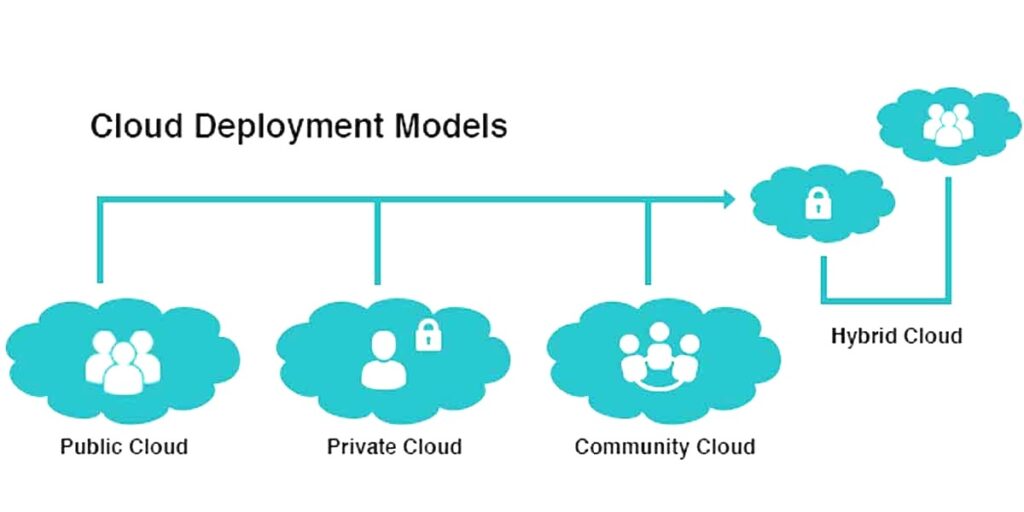Cloud deployment models play a pivotal role in the digital infrastructure of modern businesses. They define how applications, services, and resources are provisioned and hosted within cloud environments. As technology continues to evolve, understanding the various deployment models becomes crucial for businesses aiming to optimize their operations, scalability, and security.

What are Cloud Deployment Models?
Cloud deployment models delineate the way cloud computing solutions are deployed and operated. These models can be broadly classified into four categories:
Public Cloud:
Public clouds are owned and operated by third-party service providers. They offer services and infrastructure to multiple clients over the Internet. This model is highly scalable, cost-effective, and requires no maintenance of underlying infrastructure by the user.
Private Cloud:
Contrary to public clouds, private clouds are dedicated to a single organization. They can be hosted on-premises or by a third-party service provider. Private clouds offer enhanced control, customization, and security but might involve higher costs.
Hybrid Cloud:
Hybrid clouds integrate both public and private cloud environments, allowing data and applications to be shared between them. It provides the flexibility of utilizing public cloud resources for non-sensitive operations while keeping critical data on private infrastructure.
Community Cloud:
Community clouds are shared among several organizations with common concerns, such as regulatory compliance. They offer a collaborative platform where resources, costs, and security measures are shared among the community members.
Comparative Analysis of Cloud Deployment Models
Each deployment model presents its unique advantages and considerations, catering to diverse business needs:
Scalability:
Public clouds are highly scalable, allowing businesses to swiftly adjust resources based on demand. Private clouds offer scalability but might involve additional infrastructure investments.
Security:
Private clouds provide a higher level of control and security, crucial for organizations handling sensitive data or adhering to strict regulatory requirements.
Cost Efficiency:
Public clouds are usually more cost-effective due to their shared infrastructure, while private clouds offer customization at the expense of higher initial investments.
Customization:
Private and hybrid clouds allow for greater customization, catering to specific organizational requirements.
Choosing the Right Cloud Deployment Model
Selecting the ideal deployment model depends on various factors:
Nature of Business:
Assess the sensitivity of data, compliance requirements, and the need for customization.
Scalability Needs:
Evaluate the fluctuating demands for resources and the scalability requirements of the business.
Budgetary Considerations:
Consider the budget constraints and the cost implications of each deployment model.
Future Growth:
Anticipate future expansion and technological advancements to ensure the scalability and adaptability of the chosen model.
Optimizing Cloud Deployment for Business Success
Successful cloud deployment involves strategic planning and meticulous execution:
Thorough Assessment:
Conduct a comprehensive analysis of business requirements, considering factors like data sensitivity, compliance, and scalability needs.
Consultation:
Seek guidance from IT experts or consultants to evaluate the best-fit deployment model aligned with business objectives.
Pilot Testing:
Implement a pilot project to assess the efficiency and compatibility of the chosen deployment model before full-scale implementation.
Regular Evaluation:
Continuously monitor and evaluate the deployed model to ensure it meets evolving business needs and technological advancements.
Conclusion
Understanding and selecting the right cloud deployment model is instrumental in harnessing the power of cloud computing to drive business growth, efficiency, and innovation. Whether opting for a public, private, hybrid, or community cloud, businesses must align their choice with their unique requirements and long-term strategies.
In the dynamic landscape of cloud technology, staying abreast of emerging trends and advancements is pivotal. By making informed decisions and leveraging the right deployment model, businesses can unlock the full potential of cloud computing for sustained success and growth.